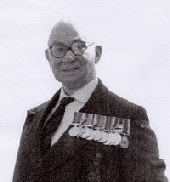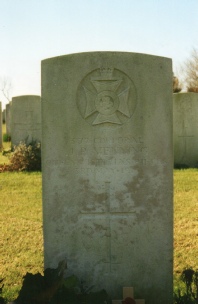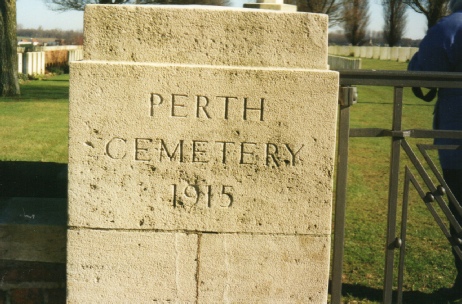



The Parish Church of St George the Martyr, Waterlooville

Winter and Lent Edition 2015
Diaries of a First World War Bugler
Late information told us that our position in the wood was given away by aviators (German) so we shifted to another just up the road where the battalion again moved off in a hurry as the Germans were making a counter-
It was here on MAY 5th 1915 at 3 o’clock in the early morning that my dear cousin Corporal Bugler J.R. Venning was killed, shot through the head. He did his duty well; may he rest in peace. This place was not so cosy as we thought.
MAY 6th 1915 saw our poor old gallant Colonel K.B. Shipley, who has taken us through so well, crack up under the strain and he was returned to England. This day also saw the last of our Adjutant, Captain Culmore Seymore, shot through the head. He was buried beside my gallant Company Commander Major Lees. After this things went on as usual. I might mention here that Captain Fleming who had died from wounds was buried in London on the 7th. During all these events we were still in trenches in the aforementioned spot where we remained until the 11th May. It was the previous day that the famous Ypres was heavily bombarded and caught fire. A lovely place it was; the last time I set eyes on it, it was reduced to ruins, the dead bodies of men, women almost naked and children scattered all over the road for many of them were killed at night when the Germans shelled. The beautiful cathedral was being knocked over bit by bit and the famous Cloth Hall was practically “ne plus”.
We were heavily shelled by Jack Johnsons during the last part of our journey which caused us all to say we sincerely hoped we never set eyes on Ypres again. The battalion, as I have already mentioned, was relieved on 11th May and a fortnight’s rest was supposed to commence and finish at a place called Lokeren. Here it was I went to the village and heard the band of the Notts and Derbys terriers. How it livened me up when the Chocolate Soldier was played!
While at this place I completely cracked up owing, I think, to the death of so many dear to me and I was sent to a pretty little place called Boeschepe where I remained for four days. Upon returning I found the battalion had not finished its rest and were now in dug-

To mark the 100th anniversary of the outbreak of World War I, we are continuing the serialisation of the diaries of Bugler John McCormack -
All went well with the boys for 5 days and then poor Sergeant Hooper, who came from Canada to join his old battalion, got killed. He was a fine soldier, mentioned in orders for work on “Hill 60”, one of the best men I have met.
The following day, JUNE 2nd 1915, I went up with Cooker and we had 3 shells at us, too near to be nice. The next day a shell dropped in the wood where a party of ‘A’ Company were chatting together. Poor Corporal Creswell was killed and 7 others wounded. I was up again the following day with Cooker when one or two stray shots came over but did no damage. Four more days have passed but, I am pleased to say, there are no casualties.
JUNE 10th 1915 saw me back in the wood and on the same night, although in reserve for a rest, we were dragged out on an engineers’ fatigue. Each man having two boards apiece, we proceeded to Q1 trench from where the sap commenced. Here one could not help noticing the improvement in the trenches, both communication and fire. While up there, a regular in front of me had part of his head blown clean away; needless to say he died soon after.
Our work in the trench being finished, we turned to return home but alas not before we had been peppered with “trench mortars”. Our destination being reached, we turned in and had a good rest. The next two days came but without anything to report. We had a service and hymns conducted by Sergeant Pulleyn D.C.M. before going into the trench which, thank goodness, was reached without trouble.
Three weeks have now passed during which time we have been heavily shelled in our little home in the wood. One shell came over and did not explode. The next morning the men of Corporal Telfer’s hut (now Sergeant) lit a fire in order to make their tea for breakfast. Suddenly we heard a loud report. I hurried to the spot to find my friend Sergeant Telfer bleeding furiously from just above the eye. He had been blown bodily into another dug-
It appears the heat of the fire had exploded this fuse which evidently belonged to the unexploded shell of the previous day. Our only other casualties were in Q2 trench, caused by “trench mortar”. 1 man killed and several wounded in ‘B’ Company.
During the aforementioned three weeks I had to make a journey to the R1 trench and you can think yourself very lucky if you get there and back without being hit. Upon leaving the wood I crossed several fields till I struck the railway line, similar to our tramlines only narrower, turning sharp to the left I proceeded along a deserted road until I came to the “engineers dump”. Turning to the right I went along passing the once merry village, now a heap of debris caused by shell-
My return journey was rather “windy” owing to being on open ground which the enemies’ flares absolutely lit up. Since we arrived at the “Scottish Wood”, which is just off the Dickebusche Road, I have visited Trenches Q1, 2 & 3, also R1, 2 & 3, all of which are very strong positions. This brings me to the end of the month of June.
To be continued
The Grave of Corporal Bugler J R Venning, John McCormack’s Cousin, at Perth Cemetery, Ypres.
The first day of a new month (May 1915) saw us bivouacking in a wood which had better be called “Somewhere in Ypres” as we were miles from anywhere. Our boys made their home as best they could from sticks and leaves using their water-

